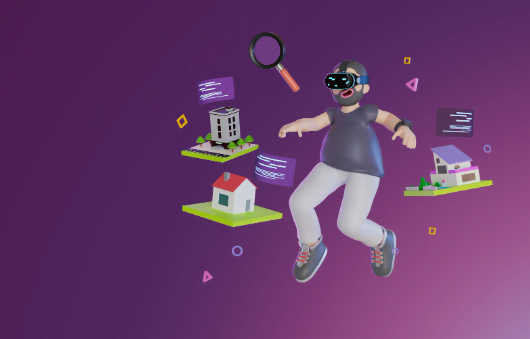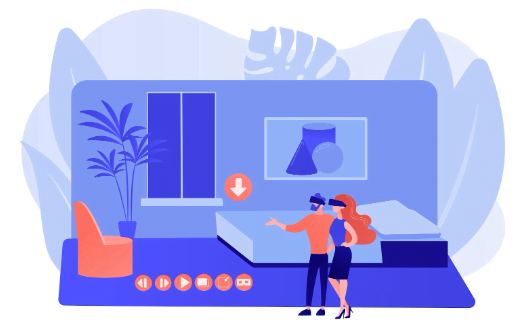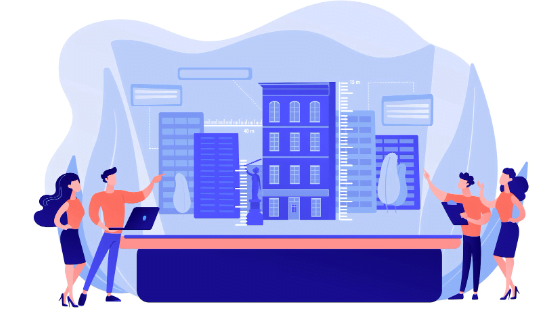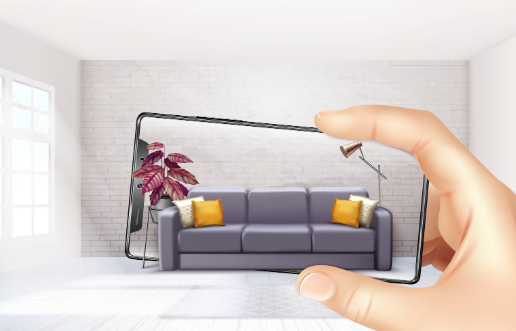|
Getting your Trinity Audio player ready... |
The first things to enter your mind upon hearing keywords like “augmented reality” and “virtual reality” might be related to gaming and entertainment. However, both of these technologies are being employed in interior design to provide customers and designers with an amazing, wholly visualized experience. AR and VR have outgrown their novel position in the design industry. As these fields of technology advance, they have been enhancing their collaboration between architects, designers, and customers. AR/VR has rapidly become indispensable tools for visualizing the design process. While planning to build a new house, people usually move mountains in order to put in their highest level of effort. They are likely to make minor compromises in the style of the decor of their homes. However, interior design may confuse an average individual unfamiliar with design. New technologies like AR and 3D Modelling make it simpler for individuals to design and customize their houses. It is no surprise that AR and VR have brought about a paradigm shift with their groundbreaking ability to merge the real-world environment with digital Reality.
How Is This Cutting Edge Technology Helping Interior Designers?
AR and VR have exceptional potential for interior designers worldwide despite being in their infant stages. 
The Difference Between AR And VR In Terms Of Design
Despite their wide use in everyday life, layman often uses these terms interchangeably, depending on their use in the world of design and architecture. Depending on the benefits of design and architecture, the difference between AR and VR is sleek yet crucial. Augmented Reality lets users place 3D models of the furniture they like in a real environment to see what the room will look like once it is furnished. In contrast, Virtual Reality is an entirely made-up virtual environment that includes 3D models of the furniture as a part of it.
Helping Designers And Engaging Clients
AR and VR technologies have been obsessed over by designers since it enables them to see their results in real-time as they work. Due to this, interior designers can experiment with numerous solutions and see immediate outcomes. On completing the design, the designer can be fully confident of the final product. Moreover, creating designs in AR or VR does not require some rocket science knowledge. Designers can upload anything flat with a 90-degree angle, like mirrors or rugs, just as they are in Reality. Other items, including furniture, light fixtures, and window treatments, have representations within the program. This breakthrough innovation gives interior designers the ability to show the client what their space will look like once completed. Clients, too, can view the vision and make changes if required. AR/VR helps eliminate the anxiety clients might feel while committing to a design plan that they are skeptical of. This interactive technology also helps attract more patrons. Clients are fascinated by the features that help them change the colors of walls and tiles used in flooring or move around the furniture. Many individuals have difficulty envisioning their area differently than they have always known it; therefore, adopting AR as a tool assists them with that image.
Designing Homes With Virtual Reality
 We all have a clear mental vision of the ideal house that we can nearly visualize in the slightest detail. We occasionally succeed in bringing our vision to Reality, but most of the time, we must compromise for something very different. Virtual reality applications allow any potential homeowner to design their dream home and have it constructed precisely as they want it. Using virtual reality apps to demonstrate a proposed house design is not only convenient for buyers but is also less expensive. Prospective purchasers may obtain a sense of the layout by seeing and walking around the digital model using virtual reality applications, changing the position of the fireplace, and adding or removing doors and windows. This option to change the layout before the house is built would undoubtedly save construction costs and accelerate project completion. Virtual Reality is the pinnacle of customization for home layouts and interior design. There will be no gaps, walls, or angles that make viewers question why it is even there. Putting up temporary curtains and moving the wardrobe about until it’s in the perfect spot will be a thing of the past. Everyone will create a house that is architecturally appropriate for the furnishings and décor they choose. If a particular piece of furniture is not accessible at a retail store, custom-made or 3D-printed items will be available to fit the designated space properly.
We all have a clear mental vision of the ideal house that we can nearly visualize in the slightest detail. We occasionally succeed in bringing our vision to Reality, but most of the time, we must compromise for something very different. Virtual reality applications allow any potential homeowner to design their dream home and have it constructed precisely as they want it. Using virtual reality apps to demonstrate a proposed house design is not only convenient for buyers but is also less expensive. Prospective purchasers may obtain a sense of the layout by seeing and walking around the digital model using virtual reality applications, changing the position of the fireplace, and adding or removing doors and windows. This option to change the layout before the house is built would undoubtedly save construction costs and accelerate project completion. Virtual Reality is the pinnacle of customization for home layouts and interior design. There will be no gaps, walls, or angles that make viewers question why it is even there. Putting up temporary curtains and moving the wardrobe about until it’s in the perfect spot will be a thing of the past. Everyone will create a house that is architecturally appropriate for the furnishings and décor they choose. If a particular piece of furniture is not accessible at a retail store, custom-made or 3D-printed items will be available to fit the designated space properly.
Building Smart Cities via AR/VR
 Smart cities influence a well-built network of connected objects, ultimately enhancing the quality of government services and citizen welfare. Now how does AR fit in over here? Augmented Reality works by superimposing digital data on real-world settings. Unlike Virtual Reality, it does not necessitate the use of heavy equipment such as a headset. All you need is a smartphone, which almost everyone has. You can be provided with constant feedback, which allows you to make informed decisions in your day-to-day life. AR can make urban spaces more citizen-centered. This can help improve urban mobility, public safety, public health, tourism, and asset management. Urban areas can get challenging to navigate. Pairing navigation apps with Augmented Reality can help make that easier. You can get directions to your destination by simply pointing your phone’s camera toward your surroundings. Having quick access to data may also be beneficial to public health and wellness. For example, AR can make it simple for locals to locate assets such as parks, recreational facilities, and outdoor activities.
Smart cities influence a well-built network of connected objects, ultimately enhancing the quality of government services and citizen welfare. Now how does AR fit in over here? Augmented Reality works by superimposing digital data on real-world settings. Unlike Virtual Reality, it does not necessitate the use of heavy equipment such as a headset. All you need is a smartphone, which almost everyone has. You can be provided with constant feedback, which allows you to make informed decisions in your day-to-day life. AR can make urban spaces more citizen-centered. This can help improve urban mobility, public safety, public health, tourism, and asset management. Urban areas can get challenging to navigate. Pairing navigation apps with Augmented Reality can help make that easier. You can get directions to your destination by simply pointing your phone’s camera toward your surroundings. Having quick access to data may also be beneficial to public health and wellness. For example, AR can make it simple for locals to locate assets such as parks, recreational facilities, and outdoor activities.
Augmented Reality- The Future of Interior Designing?
 The practical applications of Augmented Reality are numerous, and big-name brands like IKEA are at the forefront of utilizing it to aid customers in visualizing their products in real-time. IKEA released its very own AR app, which allows users to digitally place furniture from the store’s catalog into a real-world environment. This helps customers to try before they buy and has led to an increase in the Swedish retailer’s sales.
The practical applications of Augmented Reality are numerous, and big-name brands like IKEA are at the forefront of utilizing it to aid customers in visualizing their products in real-time. IKEA released its very own AR app, which allows users to digitally place furniture from the store’s catalog into a real-world environment. This helps customers to try before they buy and has led to an increase in the Swedish retailer’s sales.
Having a Virtual Tour of the Property
When purchasing a new real estate property or assessing a house project’s final appearance, feel, and usability elements, guided virtual tours may be extremely beneficial to clients in assessing the property or the ultimate post-development outcome. Modern building architects may now create a guided tour in which they can really move around and navigate utilizing perspective technology.
AR-Based Floor Planning
A floor plan is crucial when it comes to architectural dealings. Thanks to Augmented Reality, the addition of a floor plan with every property listing has now become possible. The old way architects worked has been drastically transformed by AR. Using it, architects can create and present floor plans to consumers in real time. Customers can propose improvements and come up with new strategies to utilize the area after viewing the floor plans and models.
Visualizing Interior Decor and Design Projects in Real-Time
A 3D image of a house can be shown. However, such models lack the actual setting and surroundings of the premise. That is precisely where augmented Reality’s capabilities show to be crucial and decisive. AR-based models on a portable device provide a more detailed and exact perspective of the property and its environs.
The Evolution of Interior Design: Virtual Reality
 Virtual Reality has made it easier for designers to persuade clients to adopt a specific finish or style. Without a doubt, virtual Reality has decreased the amount of back and forth over design decisions. Design teams and other stakeholders can assess if a design meets expectations or whether particular components should be altered or deleted. It confines uncertainty to the design development phase, allowing design teams to be more flexible during conception and efficient throughout implementation. Architects and designers utilize 2D drawings to express their ideas to their customers and colleagues. However, some people have difficulty comprehending 2D drawings, especially if they lack a reference point. Until recently, many designers sought to tackle this challenge by constructing scaled 3D representations and architectural models. Virtual Reality is used by architects to bring floor plans and 3D drawings to life. It may also facilitate the process of design modification and feedback, as well as avoid adjustments later on that occur because something was not fully understood, or the translation to three dimensions encourages new ideas on the side of the clients. They have already seen and experienced new environments through virtual Reality. VR might also be useful when collaborating with other specialists on a large project. Fewer meetings and faster decision-making can follow from all parties being able to meet online.
Virtual Reality has made it easier for designers to persuade clients to adopt a specific finish or style. Without a doubt, virtual Reality has decreased the amount of back and forth over design decisions. Design teams and other stakeholders can assess if a design meets expectations or whether particular components should be altered or deleted. It confines uncertainty to the design development phase, allowing design teams to be more flexible during conception and efficient throughout implementation. Architects and designers utilize 2D drawings to express their ideas to their customers and colleagues. However, some people have difficulty comprehending 2D drawings, especially if they lack a reference point. Until recently, many designers sought to tackle this challenge by constructing scaled 3D representations and architectural models. Virtual Reality is used by architects to bring floor plans and 3D drawings to life. It may also facilitate the process of design modification and feedback, as well as avoid adjustments later on that occur because something was not fully understood, or the translation to three dimensions encourages new ideas on the side of the clients. They have already seen and experienced new environments through virtual Reality. VR might also be useful when collaborating with other specialists on a large project. Fewer meetings and faster decision-making can follow from all parties being able to meet online.
How Is 3D Animation Better Than CGI?
 For architects and designers to exhibit their designs, 3D interior animation has become an indispensable tool. Even the highest quality still CG images cannot convey a complete picture of the interior design project. The issue is that they are immobile and only display the space from one or a few angles. With the introduction of 3d animation, this scenario has radically transformed. With still images and 3D floor plans, architects can now display the potential outcomes of their projects.
For architects and designers to exhibit their designs, 3D interior animation has become an indispensable tool. Even the highest quality still CG images cannot convey a complete picture of the interior design project. The issue is that they are immobile and only display the space from one or a few angles. With the introduction of 3d animation, this scenario has radically transformed. With still images and 3D floor plans, architects can now display the potential outcomes of their projects.
3D ANIMATION ENHANCES THE IMPRESSION THROUGH MUSIC AND VOICE-OVERS
In contrast to static images, 3D interior animation can include a soundtrack. Depending on the nature and aim of an architecture project, music must be chosen to assist express the proper message. It will create the tone, engage the audience, and guide them through the material, emphasizing the essential moments.
3D ANIMATION SHOWS HOW INTERIOR AND EXTERIOR WORK TOGETHER
3D animation frequently depicts not just the interior but also the exterior of a property. In addition, unlike still photographs, which display them individually, a 3D video may depict both the outside and inside of the home as integrated components of the entire.
INTERIOR ANIMATION SHOWS TRANSITIONS BETWEEN ROOMS
Even the greatest quality CG images lack motion and so cannot represent the entire picture of an interior project. Even though they present all materials, furniture, décor, and layout ideas in great detail, each space is showcased individually from the others. As a result, the display gets fragmented.
3D ANIMATION CONVEYS THE ATMOSPHERE BETTER THROUGH MOTION
People view interior designs in still representations to be fully static settings. However, this is not the case in real life. A 3D interior animation may address this void by depicting interiors as they would seem in real life. Its capacity to portray things in motion may bring life to any scene and provide a spectator with an immersive life-like experience that elicits a powerful emotional reaction.
Logging Out
The future of interior design will be dominated by Augmented Reality and Virtual Reality. With these technologies, formerly impossible undertakings are now doable. Printed catalogs might be out of date, but they help to make interior design smarter, more convenient, and more colorful. People like to examine new designs and furniture before making a purchase. They desire to be motivated and transform their surroundings. New technologies enable them to do so in the most efficient manner possible. Furthermore, the use of AR and VR in interior design will benefit both consumers and sellers. If you work in the interior design industry, you should take advantage of AR and VR. AR and VR will propel your company to new heights.

